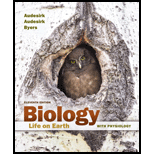
Concept explainers
Suppose an experiment is performed in which plant I is supplied with normal carbon dioxide but with water that contains radioactive oxygen atoms. Plant II is supplied with normal water but with carbon dioxide that contains radioactive oxygen atoms. Each plant is allowed to perform photosynthesis, and the oxygen gas and sugars produced are tested for radioactivity. Which plant would you expect to produce radioactive sugars, and which plant would you expect to produce radioactive oxygen gas? Explain why.
To describe:
Among the two types of plants whether plant I (grown with normal carbon dioxide and water containing radioactive oxygen) or plant II (grown with normal water and carbon dioxide containing radioactive oxygen) will produce radioactive sugars and whether plant I or plant II will produce radioactive oxygen gas.
Introduction:
The photosynthesis can be defined as the process through which the plants or the autotrophs produce food using the carbon dioxide, water, and sunlight. The photosynthesis inside the chloroplast takes place in two different stages, light reactions and carbon reactions or dark reactions.
Explanation of Solution
In an experiment Plant I is grown in normal carbon dioxide but with water containing radioactive oxygen atoms and plant, II is grown in radioactive oxygen in carbon dioxide and with normal water.
As the oxygen is released from photolysis of water which takes place during the photosynthesis, plant I will release oxygen-containing radioactivity. Photolysis can be defined as the splitting of the water molecule by the enzymes which are present in photosystem II. Photolysis facilitates the continuous supply of electrons to photosystem II. The overall reaction of photolysis can be shown as below:
Where,
The sugars are formed in the dark reactions or carbon reactions. During this phase, the plants absorb carbon dioxide which combined with
Where,
Since, the oxygen is released from the photolysis of water molecule, the plant I (grown with normal carbon dioxide and water containing radioactive oxygen) will produce radioactive oxygen. The sugars are formed from the combining of carbon dioxide with
Want to see more full solutions like this?
Chapter 7 Solutions
Biology: Life on Earth with Physiology (11th Edition)
- How is a protein destined for the Endoplasmic Reticulum (ER), imported into the ER? Be concise.arrow_forwardFind out about the organisations and the movements aimed at the conservation of our natural resources. Eg Chipko movement and Greenpeace. Make a project report on such an organisation.arrow_forwardWhat are biofertilizers and mention the significancearrow_forward
- PCBs and River Otters: Otters in Washington State’s Green-Duwamish River have high levels of polychlorinated biphenyls (PCBs) in their livers. PCBs can bind to the estrogen receptors in animals and disrupt the endocrine system of these otters. The PCBs seem to increase the estrogen to androgen ratio, skewing the ratio toward too much estrogen. How would increased estrogen affect the river otter population? Based on your reading of the materials in this unit, what factors can affect fertility in humans? Explain how each of the factors affecting human fertility that you described can disrupt the human endocrine system to affect reproduction.arrow_forwardOther than oil and alcohol, are there other liquids you could compare to water (that are liquid at room temperature)? How is water unique compared to these other liquids? What follow-up experiment would you like to do, and how would you relate it to your life?arrow_forwardSelection of Traits What adaptations do scavengers have for locating and feeding on prey? What adaptations do predators have for capturing and consuming prey?arrow_forward
- Competition Between Species What natural processes limit populations from growing too large? What are some resources organisms can compete over in their natural habitat?arrow_forwardSpecies Interactions Explain how predators, prey and scavengers interact. Explain whether predators and scavengers are necessary or beneficial for an ecosystem.arrow_forwardmagine that you are conducting research on fruit type and seed dispersal. You submitted a paper to a peer-reviewed journal that addresses the factors that impact fruit type and seed dispersal mechanisms in plants of Central America. The editor of the journal communicates that your paper may be published if you make ‘minor revisions’ to the document. Describe two characteristics that you would expect in seeds that are dispersed by the wind. Contrast this with what you would expect for seeds that are gathered, buried or eaten by animals, and explain why they are different. (Editor’s note: Providing this information in your discussion will help readers to consider the significance of the research).arrow_forward

 Concepts of BiologyBiologyISBN:9781938168116Author:Samantha Fowler, Rebecca Roush, James WisePublisher:OpenStax College
Concepts of BiologyBiologyISBN:9781938168116Author:Samantha Fowler, Rebecca Roush, James WisePublisher:OpenStax College Biology: The Dynamic Science (MindTap Course List)BiologyISBN:9781305389892Author:Peter J. Russell, Paul E. Hertz, Beverly McMillanPublisher:Cengage Learning
Biology: The Dynamic Science (MindTap Course List)BiologyISBN:9781305389892Author:Peter J. Russell, Paul E. Hertz, Beverly McMillanPublisher:Cengage Learning Biology (MindTap Course List)BiologyISBN:9781337392938Author:Eldra Solomon, Charles Martin, Diana W. Martin, Linda R. BergPublisher:Cengage Learning
Biology (MindTap Course List)BiologyISBN:9781337392938Author:Eldra Solomon, Charles Martin, Diana W. Martin, Linda R. BergPublisher:Cengage Learning Biology 2eBiologyISBN:9781947172517Author:Matthew Douglas, Jung Choi, Mary Ann ClarkPublisher:OpenStax
Biology 2eBiologyISBN:9781947172517Author:Matthew Douglas, Jung Choi, Mary Ann ClarkPublisher:OpenStax Biology Today and Tomorrow without Physiology (Mi...BiologyISBN:9781305117396Author:Cecie Starr, Christine Evers, Lisa StarrPublisher:Cengage Learning
Biology Today and Tomorrow without Physiology (Mi...BiologyISBN:9781305117396Author:Cecie Starr, Christine Evers, Lisa StarrPublisher:Cengage Learning





